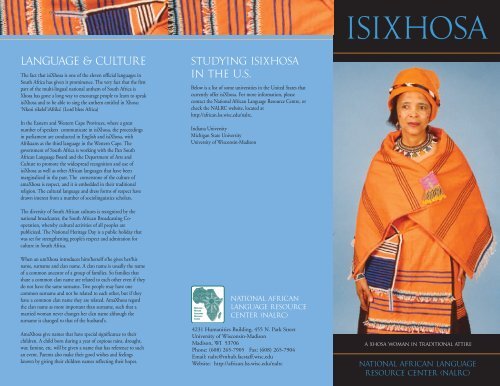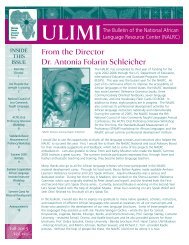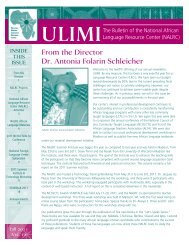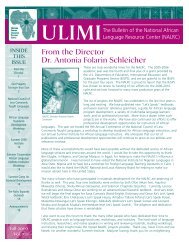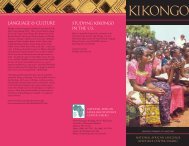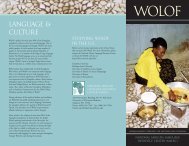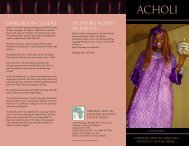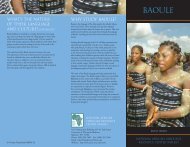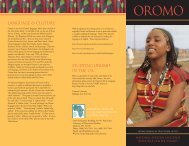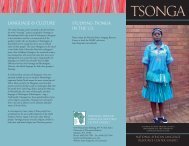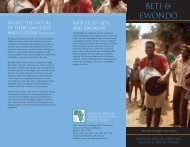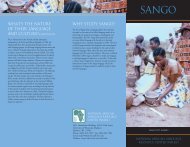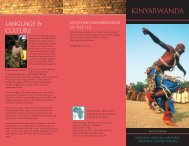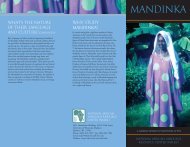isixhosa - National African Language Resource Center - Indiana ...
isixhosa - National African Language Resource Center - Indiana ...
isixhosa - National African Language Resource Center - Indiana ...
Create successful ePaper yourself
Turn your PDF publications into a flip-book with our unique Google optimized e-Paper software.
<strong>isixhosa</strong><br />
<strong>Language</strong> & Culture<br />
The fact that isiXhosa is one of the eleven official languages in<br />
South Africa has given it prominence. The very fact that the first<br />
part of the multi-lingual national anthem of South Africa is<br />
Xhosa has gone a long way to encourage people to learn to speak<br />
isiXhosa and to be able to sing the anthem entitled in Xhosa:<br />
‘Nkosi sikelel’iAfrika’ (Lord bless Africa)<br />
In the Eastern and Western Cape Provinces, where a great<br />
number of speakers communicate in isiXhosa, the proceedings<br />
in parliament are conducted in English and isiXhosa, with<br />
Afrikaans as the third language in the Western Cape. The<br />
government of South Africa is working with the Pan South<br />
<strong>African</strong> <strong>Language</strong> Board and the Department of Arts and<br />
Culture to promote the widespread recognition and use of<br />
isiXhosa as well as other <strong>African</strong> languages that have been<br />
marginalized in the past. The cornerstone of the culture of<br />
amaXhosa is respect, and it is embedded in their traditional<br />
religion. The cultural language and dress forms of respect have<br />
drawn interest from a number of sociolinguistics scholars.<br />
Studying <strong>isixhosa</strong><br />
in the U.S.<br />
Below is a list of some universities in the United States that<br />
currently offer isiXhosa. For more information, please<br />
contact the <strong>National</strong> <strong>African</strong> <strong>Language</strong> <strong>Resource</strong> Centre, or<br />
check the NALRC website, located at<br />
http://african.lss.wisc.edu/nalrc.<br />
<strong>Indiana</strong> University<br />
Michigan State University<br />
University of Wisconsin-Madison<br />
The diversity of South <strong>African</strong> cultures is recognized by the<br />
national broadcaster, the South <strong>African</strong> Broadcasting Cooperation,<br />
whereby cultural activities of all peoples are<br />
publicized. The <strong>National</strong> Heritage Day is a public holiday that<br />
was set for strengthening people’s respect and admiration for<br />
culture in South Africa.<br />
When an umXhosa introduces him/herself s/he gives her/his<br />
name, surname and clan name. A clan name is usually the name<br />
of a common ancestor of a group of families. So families that<br />
share a common clan name are related to each other even if they<br />
do not have the same surname. Two people may have one<br />
common surname and not be related to each other, but if they<br />
have a common clan name they are related. AmaXhosa regard<br />
the clan name as more important than surname, such that a<br />
married woman never changes her clan name although the<br />
surname is changed to that of the husband’s.<br />
AmaXhosa give names that have special significance to their<br />
children. A child born during a year of copious rains, drought,<br />
war, famine, etc. will be given a name that has reference to such<br />
an event. Parents also make their good wishes and feelings<br />
known by giving their children names reflecting their hopes.<br />
<strong>National</strong> <strong>African</strong><br />
<strong>Language</strong> <strong>Resource</strong><br />
<strong>Center</strong> (NALRC)<br />
4231 Humanities Building, 455 N. Park Street<br />
University of Wisconsin-Madison<br />
Madison, WI 53706<br />
Phone: (608) 265-7905 Fax: (608) 265-7904<br />
Email: nalrc@mhub.facstaff.wisc.edu<br />
Website: http://african.lss.wisc.edu/nalrc<br />
A Xhosa woman in traditional attire<br />
<strong>National</strong> <strong>African</strong> <strong>Language</strong><br />
<strong>Resource</strong> <strong>Center</strong> (NALRC)
Why Study <strong>isixhosa</strong><br />
IsiXhosa is a very beautiful language with unique and striking<br />
features. People throughout the world are fascinated by the<br />
clicking sounds that occur in isiXhosa. A number of students<br />
have put forth a variety of reasons for studying the isiXhosa<br />
language in the United States. Some have research interests,<br />
while others are interested in studying about cultures of South<br />
<strong>African</strong>s. The rich history of amaXhosa (people who speak<br />
isiXhosa) has gripped the interests of many a student who has<br />
heard of names and phenomena like Nongqawuse, who was at<br />
the center of what became known as The Xhosa <strong>National</strong><br />
Suicide and Enoch Sontonga, who composed the famous<br />
national anthem - Nkosi Sikelel’iAfrika. A number of people<br />
want to study isiXhosa simply because it is the home language<br />
of one of the world’s best statesmen – Mr Nelson Rolihlahla<br />
Mandela.<br />
A knowledge of isiXhosa enables one to communicate easily<br />
with speakers of other Nguni languages: isiZulu, isiNdebele<br />
and isiSwati. So learning isiXhosa can actually be a gateway to<br />
speaking four South <strong>African</strong> languages. IsiXhosa is one of<br />
eleven official languages of South Africa, and it is the home<br />
language of people settled over a vast area of the Eastern and<br />
Western Cape Provinces – an area stretching from the Indian<br />
Ocean in the East to the Atlantic Ocean in the West. A<br />
number of development projects and industries that are<br />
funded by overseas company are situated in the area occupied<br />
by amaXhosa, so a communicative competence in this<br />
language puts research workers in very good standing. A<br />
knowledge of isiXhosa comes in handy in Gauteng Province,<br />
the richest, busiest and most prosperous province in South<br />
Africa, because the majority of people in that province speak a<br />
Nguni language.<br />
Foreign diplomats, business and education directors,<br />
international aid workers, missionaries, volunteers of the Peace<br />
Corps, etc. benefit greatly from a knowledge of isiXhosa<br />
because they can communicate with more than 70% of the<br />
South <strong>African</strong> community.<br />
Included in the isiXhosa lessons are skills for making jewelry<br />
and other isiXhosa artifacts from beads. Students also have fun<br />
learning how to sing Mirriam Makeba’s famous click song:<br />
‘Uqongqothwane’ With the move towards globalization, the<br />
importance of empowering oneself with communicative<br />
competence in many languages cannot be overemphasized.<br />
Learning how to speak isiXhosa will improve any student’s<br />
chances of participating in the global village that is our world.<br />
Who Speaks <strong>isixhosa</strong><br />
People and History<br />
The majority of isiXhosa speakers live in the Eastern and<br />
Western Cape Provinces of South Africa. There is a great<br />
number of isiXhosa speakers in the Gauteng Province and an<br />
insignificant number in the Northern Cape . Altogether there is<br />
a total number of about 7 million isiXhosa speakers in South<br />
Africa.<br />
AmaXhosa, the people who speak the Xhosa language, are said<br />
to be descendants of an Egyptian king named Nuto, who lived<br />
about the 3rd century AD. (Soga. 1954) History has it that<br />
king Nuto had many sons from his many wives, some of whom<br />
moved towards the South in search of better grazing land for<br />
their growing herds. In these series of slow migrations, the<br />
people fanned out into the subcontinent and settled in large<br />
groups – each group consisting of a number of tribes. Within<br />
these groups or tribes there emerged young men with excellent<br />
leadership skills. Such leaders would organize hunting<br />
expeditions whereby both males and females participated –<br />
males to hunt, females to cook.<br />
One of these groups, the Nguni, settled on the south-east<br />
<strong>African</strong> coast. It was amongst this Nguni group that two<br />
brothers, Zulu and Xhosa emerged. They moved further<br />
towards the south, always hunting and herding cattle. So, even<br />
though Xhosa was not meant to be a chief, his hunting parties<br />
urged him to form a separate group from his brother’s, and so<br />
he became their chief. Thus, the two descendants of king Nuto,<br />
Zulu and Xhosa, found themselves separated by hunting<br />
strategy and ideology, but united in blood. Hence to this day<br />
the amaZulu and amaXhosa people have almost identical<br />
languages.<br />
The nation of amaXhosa is made up of many groups,<br />
commonly known as tribes, who all speak isiXhosa with a few<br />
differences in their vocabularies and structure. Such groups<br />
include: AmaHlubi, amaMfengu, amaBhaca, amaBomvana,<br />
amaMpondo.<br />
Young Xhosa woman grinding maize in a village in South Africa<br />
Children playing along the road<br />
near Queensland<br />
A teacher teaching Xhosa culture to a child<br />
A Xhosa woman in native attire


